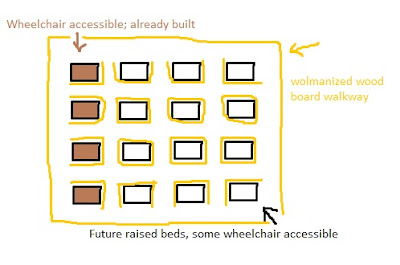I have much good news, and some new ideas! First, let's address the business aspect.
Land Use for Gardeners at the AACIL
After a good conversation with our CEO, Jim Magyar, AACIL gardeners have been granted the full use of a whole lotta land. Check out my rough diagram of that land area below.
I'd estimate that we're working with about 50' x 100' of land. (Of course, Don could probably better estimate.)
What we can do with that land: pretty much anything, so long as it's basically nice to look at. That includes roto-tilling sections and practicing traditional row-and-furrow gardening, building raised beds, building walkways, etc.
This means that the sky is the limit in terms of our possibilities for garden design.
Garden Design: Jim's Recommendations
Jim and I discussed the walkway proposals that we as a group have been working on -- the wooden walkway built from reclaimed pallets and the upturned-carpet walkway. Jim heard my ideas out, but seemed very interested in seeing us use wolmanized boards for walkways. Here's a rough drawing of his proposal:
The wolmanized wood boards would be laid on the leveled ground between these plots and around their perimeter. The boards would be secured in place by wood stakes.
It looks likely that we would find a way to cover the cost of all building materials for this plan, if we were to pursue it.
Like I said, however, we have a huge land area to work with. Even if we did install all these plots and the walkway system as represented in the drawing above, we would only be using 36' x 36' of our approx. 50' x 100' of gardening space.
My New Idea: Straw Bale Gardening
After you've read that, tell me you don't want to try it! I know I sure do.
The straw bale method is perfect for accessibility purposes and it doesn't require much soil or weeding as the plants grow. Moreover, it's cheap: We could get straw bales for $2 apiece. That means we could have about 100 square feet of raised, accessible growing space for $40. The bales wouldn't last for more than two seasons, but the decomposed straw they leave behind would only work to build up our soil. We would need to have these bales within the next 10 days - 2 weeks so that they would be properly prepared in time for spring planting.
I propose, then, that we buy 20 bales to use as accessible gardening space. If we do so, we would not need to build any additional lumber-based, wheelchair accessible plots this season.
What does everyone think of these proposals?






